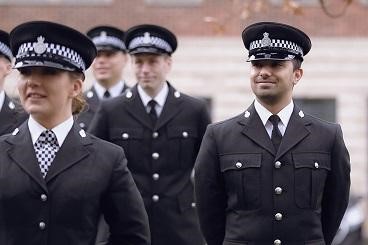You are here
Learning from each other: Opportunities and challenges working with a policing force

Ahmed Kadry is the Qualification Lead for the Police Constable Degree Apprenticeship, one of the new entry routes in becoming a police officer. He writes on the opportunities and challenges in working closely with a police force to enable student officers to apply their degree learning in the workplace.
In 2017, the College of Policing, the professional body in England and Wales that overseas training and development of police officers, revealed a new training delivery plan for all new police recruits: The Police Education Qualification Framework (PEQF). The PEQF laid out three new entry routes for new police officers, one of which is the Police Constable Degree Apprenticeship (PCDA). The PCDA sees new recruits study for their three-year degree apprenticeship as they embark on their policing careers.
In 2018, the OU began to form its policing team to explore opportunities in delivering against the PEQF, and in 2019, won the contract to be the university provider to North Yorkshire Police (NYP). Focusing first on the PCDA, a fully integrated apprenticeship degree, the two organisations have had to work very closely together in order enhance both the employer and student experience while also ensuring compliance with College of Policing guidelines as well as that of the Education Skills and Funding Agency (ESFA). So after 21 months of our very first cohort, what opportunities and challenges have arisen so far in working closely with NYP?
Perhaps the first opportunity came during the module production process and giving consideration to what assessment strategy we wanted to utilise to fairly assess the knowledge students have attained from both their academic studies but also from the workplace. For the work-based learning modules, reflective assignments have been utilised, allowing students to reflect on their specific experiences in the workplace, asking them to identify what they feel they did well and what they wish to improve upon.
A measure of specificity and customisation has also been possible on the TMAs for the academic modules, where students are given a specific scope for the TMA, such as selected theories that explain crime, but can apply these theories to their own police force. For example, their first TMA in year two (by which point they would have been serving officers for 18 months) asks them to evaluate NYP’s internal threat assessments in relation to future threats and considerations in policing. Working closely with key personnel from staff from NYP’s intelligence and analytical teams, this document is available to the students so that they can complete their TMAs.
However, a second benefit has arisen, where beyond the mark awarded to each TMA, NYP have also expressed an interest in being given sight (with student permission) of the TMAs that provide a thorough critique of the threat assessment as an avenue of feedback for those have produced it. For example, have students identified an issue which hasn’t been included but should be? Have the documents highlighted an issue which may be national but will likely not impact rural North Yorkshire?
On a larger scale beyond TMAs, the students in their third year must complete an End Point Assessment project. We have worked closely with NYP in recent months to ensure that the project titles do not just adequately assess the student’s ability to demonstrate their academic knowledge and acquired skills over the three years to meet the apprenticeship standard, but projects that can simultaneously confer a benefit to NYP in being able to serve their communities. In other words, the project titles and aims are not abstract or limited to the theoretical but grounded in very real issues and concerns that the EPA project seeks to address. For example, rather than a student focusing on Anti-Social Behaviour or the supply of drugs across county borders (known as County Lines) in theoretical terms, their project must seek to localise the issue and provide methods for how they wish NYP and relevant partner agencies in the area to address the specific problem in North Yorkshire. In other words, each EPA project is designed and delivered as a real-life policing intervention and takes place in real-time, where a large component of the EPA project is evaluating the strengths and weaknesses of the intervention.

Figure 1: Student officers during their pass out parade after their initial training.
There of course have been challenges. Students must throughout the three years manage their workload and their time effectively and not fall behind in either the workplace or their degree. Joining the police in of itself represents a challenge where officers must quickly acclimatise to learning legislation and understanding how to apply it, adapt to shift patterns and being equipped and confident to carry out their policing powers. While 20% of their workload has been designated for their degree study, the fast-paced nature of policing means that this protected time cannot always be easily identifiable or added into shift patterns as normal routine. However, in instances where a student has expressed concern or either the OU or NYP have identified a concern, we have worked together to add further support. Most recently, a student’s shift pattern was changed to provide them with the time they needed to hand in a TMA on time.
Another significant challenge has been making adjustments to the PCDA in real-time. All of the modules are new and so we have been heavily reliant on real-time feedback from both students and staff from NYP’s Professional Development Unit. Longer-term scholarship projects are underway, but in the meantime, we have had to make decisions based off the information available. The challenge has been deciding what changes to make and what changes to resist. Do we make a change to a TMA based off the feedback of some students from one cohort or leave it as it is? Do we challenge NYP because an Associate Lecturer has been told by a student that they are not being given enough time to study in the workplace or treat this as an individual anomaly, with the added tension we cannot allow a student to passively fail the degree?
Overall, thus far the partnership and knowledge exchange between the two organisations has been positive. We’ve been able to identify areas of the national curriculum where each organisation has responsibility and have developed mechanisms to share responsibility as well. Perhaps most importantly, the student journey is not two separate vacuums of academic study on one side and operational practice on the other. With the two organisations working closely together, a continuous feedback loop has arisen where the OU’s degree component and NYP’s operational component speak to each other, which in turn should make it clearer to the student officers of how their degree studies enhance their ability to fulfil their role as police constables, now and in the future.
